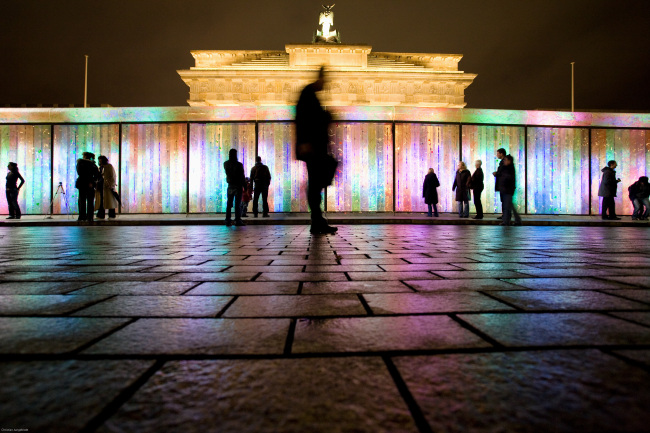
이은숙 작가, 2월 23일부터 3월 10일까지 임진각 자유의 다리 민통선 철조망에서 이산가족의 아픔을 담은 조명 설치작품 선보인다.
6.25전쟁이 끝나고 휴전이 된지 올해로 60주년이 되었다. 이제 유일한 분단 국가로 남은 한국에는 여전히 전쟁의 상흔이 아픔과 한으로 남아 있다. 북쪽에 두고 온 가족은 생사도 모른 채 60년이 흘러 이산 당사자 세대는 계속 세상을 등지고 있어 이제 역사의 기록 속으로 사라지고 있다.
정전 60년을 맞은 2013년. 우리 민족이 하나가 되기를 기원하는 조명설치작품이 임진각 자유의 다리 민통선 철조망에 설치된다. 이 작품은 DMZ 철조망을 따라 설치하려 하였으나 군 부대 작전 보안상 문제로 임진각으로 자리를 옮겼다.
이산가족 아버지를 둔 이은숙 작가는 6.25전쟁 당시 사진과 헤어진 가족에 대한 사연을 묶어 북쪽에 있는 잊혀져가는 그리운 가족의 이름을 불러낸다. 그들을 기억하기 위해 이름의 자음, 모음을 작품으로 제작하여 철조망을 따라 조명과 같이 설치한다.
작가의 아버지는 전쟁때 4명의 자녀를 북쪽에 두고왔지만 2년전 이 세상을 떠났다.
작가는 이산가족을 주제로한 작품을 해외에서 먼저 선보였다.2007년 베를린 브란덴부르크 문에서 이산가족 5,000명의 이름을 주제로한 조명설치작업을 선보였고, 현지의 엄청난 관심을 끌었다.
작품은 독일 주요 신문뿐만 아니라 BBC, CNN, 로이터에도 언급이 됐다.
“우리는 아직도 이산의 아픔을 갖고 있잖아요. 이런 아픔이 사람들의 마음을 자극한 것 같아요.” 라고 작가는 말했다.
작가는 투명 폴리에스텔 필름에 다양한 색상의 형광실을 압착시켜 입체물을 만든다. 그 내부에 UV 라이트를 조명으로 사용해 이미지를 드러나게 함으로써 작가가 전달하고자 하는 메시지에 주목하게 한다.
작가는 임진각 이외 서울 광화문에서도 비슷한 설치작업을 하고 싶다는 희망을 나타냈다.
“독일에서 돌아온 이후, 서울의 조명이 유원지 느낌이 난다는 인상을 받았어요. 그래서 광화문에서 새로운 빛 설치작업을 하고 싶었어요.” 라고 작가는 말했다.
“아직 기획중인데 우리나라 근대사가 들어갈 것 같아요.”
사실 이은숙 작가는 한국에서 활동하다가 작품에 대한 혹평을 듣고 독일에서 새로운 출발을 한 작가다.
“한국에는 내가 쓰는 재료를 싸구려 취급하고, 비닐이나 형광색이 유치하다든가 라는 말을 들었어요. 그런데 외국에서는 그런 이야기를 들은적이 없고 재료 자체를 인정하는거죠.” 라고 작가는 말했다.
2000년에 한국을 떠나고 독일에서 한-독일 작가 그룹전에 참가한 작가는 오히려 독일에서 인정을 받고 다시 한국에 돌아왔다.
“이번 임진각 작품을 시작으로 한국에서 작품활동에 탄력을 받았으면 좋겠어요.” 라고 작가는 기대를 나타냈다.
(코리아헤럴드 이우영 기자)
<관련 영문 기사>
Calling out names of families separated in Korean War
By Lee Woo-young
With nearly 60 years having passed since the end of the Korean War, memories of war have faded away as new generations grow away from history. But the memories remain very vivid to the separated families and are a true reminder of the painful history of the war.
Artist Lee Eun-sook, a second generation of separated families whose father left four children in the North and died two years ago, keeps the fading memories alive by using the forgotten names of the divided families in the North and South as the main materials for her light installation.
So far, those names have only been seen in a foreign land. Her first light installation, featuring 5,000 names of families separated during the Korean War, was first introduced in Berlin at the Brandenburg Gate in 2007.
The light installation attracted huge attention as it was covered on the front pages of major newspapers in Germany. The exhibition was also reported on in the major media outlets such as the BBC, Reuters and CNN.
“There is still the pain of separation in Korea. And I think this sad reality touched the hearts of many viewers,” said Lee in a recent interview with The Korea Herald.
“Some people shed tears and some people told me they were moved and impressed by the artwork,” said Lee.
On Feb. 23, Lee is presenting a new installation work at the Freedom Bridge, one symbol of the Korean War, near the border village of Imjingak.
The 25-meter installation will feature consonants and vowels from the names of separated families with their pictures flashed through fluorescent light created from fluorescent-colored threads and ultraviolet light.
The light installation will be on exhibit from Feb. 23-March 10 at the barbed wire fence near the Freedom Village at Imjingak.
“I wanted to display it along the DMZ, but the military didn’t allow it,” said Lee. “But it’s meaningful that it is exhibited in such a symbolic spot,” she added.
The artist said she hopes to continue her installation project in other historical places in the country.
“Maybe in Gwanghwamun. After I returned to Korea from Germany, I found the lights of the central Seoul had too much of an amusement park feel. I am developing my idea for the Gwanghwamun installation piece. But I think I will include the modern history of Korea,” said Lee.
The exhibition at Imjingak is also the first exhibition she is holding after she left Korea in 2000.
Lee, who graduated Ehwa Womans University, where she studied textile art, in 1979, held several exhibitions in Korea that were met with harsh reviews from critics.
“They said the materials and fluorescent colors looked too cheap,” she said.
Lee started her second career in Germany after she was offered a chance to participate in a group exhibition of Korean and German artists.
“A curator from Frankfurt approached me at an exhibition in Korea and said I was the one she was looking for and she liked it that there’s much work done by hand,” she said.
“And they found the subject of my work related to the separated families during the war special,” said Lee.
“I hope people in Korea also feel the same thing and understand the pains and memories of separated people through my work,” said Lee.
(wylee@heraldcorp.com)








![[LLG] Unseen inheritance: Trauma of transnational adoption 'trickles down' to adoptees' children](http://res.heraldm.com/phpwas/restmb_idxmake.php?idx=644&simg=/content/image/2024/05/12/20240512050141_0.jpg&u=20240512163544)
![[KH Explains] Hyundai Motor’s plan for new landmark keeps hitting bumps](http://res.heraldm.com/phpwas/restmb_idxmake.php?idx=644&simg=/content/image/2024/05/13/20240513050626_0.jpg&u=20240513192803)








